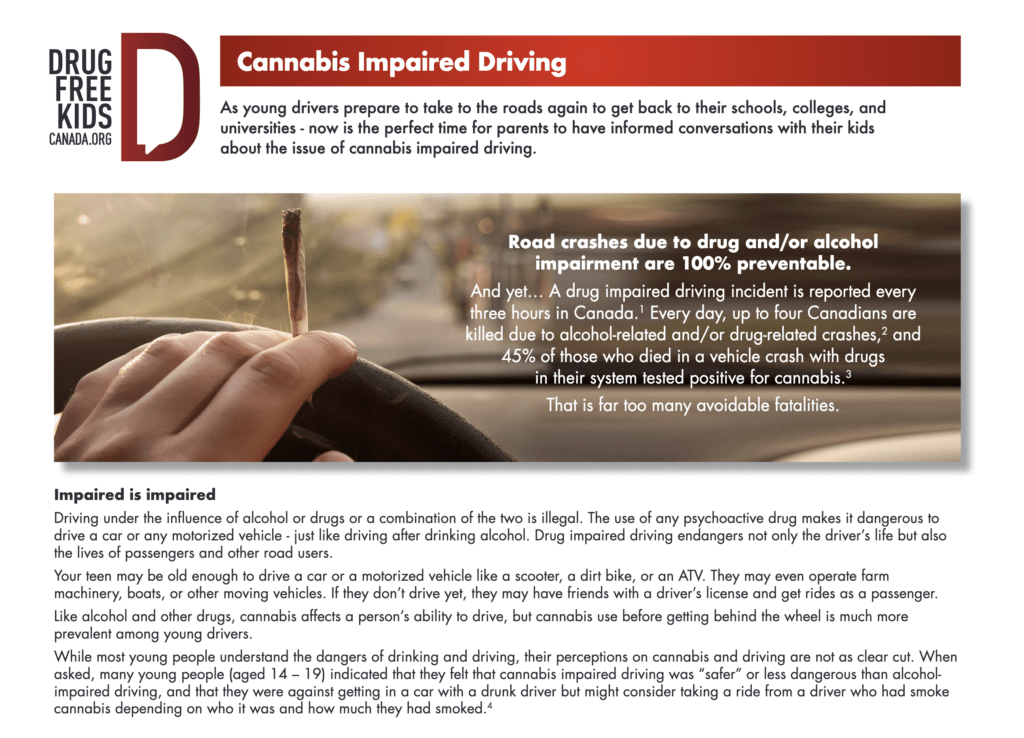Help your teen understand the dangers of driving under the influence of alcohol or drugs
Impaired driving refers to driving a motor vehicle while impaired by any type of drug or medication or combination of drugs, medications, and alcohol. These can include cannabis, illegal substances, mind-altering prescription medications, and over-the-counter remedies and medications that affect an individual’s ability to drive safely.

Your teen may be old enough to drive a car or any motorized vehicle like an ATV or dirt bike or operate farm machinery, lawnmowers, boats, or other moving vehicles. Young drivers are already at a higher risk of road accidents, as new drivers often lack experience behind the wheel.
They should know that just like alcohol, cannabis in any form – including edibles – can seriously impair the ability to operate machinery or vehicles of any kind.
Studies show that driving high nearly doubles the risk of an accident, and a study commissioned by DFK Canada in 2017 found that over one third (37%) of teens feel that driving high is not as risky as drunk driving, while one in four high school seniors say they have ridden in a car with a high driver.
There are a few common misperceptions regarding drugs and driving among youth:
- Impaired driving is not a serious problem;
- Cannabis-impaired driving is safer than alcohol-impaired driving;
- Some drug use does not adversely affect driving ability;
- Some drug use improves driving ability due to compensation strategies; and
- The likelihood of being pulled over for impaired driving is low.
Cannabis and Driving
Explore common myths together with young drivers and learn the facts together – it is a great way for you and your kids to have a greater understanding of the issue of cannabis impaired driving. (Click on image to download)
The Effects of Drugs on Driving:
Cannabis
Cannabis significantly affects the skills necessary for driving. Cannabis causes euphoria, slowed thinking, confusion, impaired memory and learning, increased heart rate and anxiety. These effects are felt within minutes, peak after about half an hour and can last up to two hours.
Research shows that impairment increases significantly when cannabis is combined with alcohol.
Driving while on cannabis demonstrates slowed thinking, which delays reaction time to important events occurring on the road. It also distorts time and distance perception, making it difficult for the driver to navigate turns into oncoming traffic. Concentration and attention span are also decreased, increasing the likelihood that the driver will be distracted from watching the road.
The crash rate of cannabis users can be anywhere from two to six times higher than sober drivers, depending on the duration and quantity of the drug.
Considerable evidence from both real and simulated driving studies indicates that cannabis can negatively affect a driver’s attentiveness, perception of time and speed, and ability to draw on information obtained from past experiences.
Illegal Drugs
The list of illegal drugs includes hallucinogens, ecstasy, cocaine, and LSD, Methamphetamine, crack, heroin, and crystal meth.
All of these cause various effects such as hallucinations, impulsivity, irritability, dizziness, anxiety, loss of coordination, and a false sense of alertness.
Cocaine is the most common illegal drug found in fatally injured drivers. It is associated with speeding, losing control of the vehicle, making unsafe turns in front of other vehicles, aggressive driving and inattentive driving. Those who drive under the influence of cocaine are two to ten times more likely to crash than an unimpaired driver.
Prescription Drugs
Prescription Drugs
Prescription drugs like painkillers, depressants or stimulants should never be taken without a prescription from a doctor and they should be used under medical supervision.
The effects of specific drugs differ depending on how they act in the brain, but all impair faculties necessary for the safe operation of a vehicle. These faculties include motor skills, balance and coordination, perception, attention, reaction time, and judgment. These drugs cause feelings of euphoria, drowsiness, and relaxation and decrease the sensation of pain.
The Bottom Line
Driving under the influence of alcohol or drugs or a combination of the two is very dangerous for anyone. The use of any psychoactive (mind-altering) drug makes it highly unsafe to drive a car and is illegal—just like driving after drinking alcohol. Driving under the influence of drugs endangers not only the driver’s life but also the lives of passengers and other road users.
What can you do?
Talk with your kids about the risks of impaired driving.
Parents can make a big difference in the lives of young drivers by staying informed about the issue and talking to their teens. Conversations with kids about risky behaviours like driving while high and being a passenger in the car with a high driver are important to have on a regular basis.







